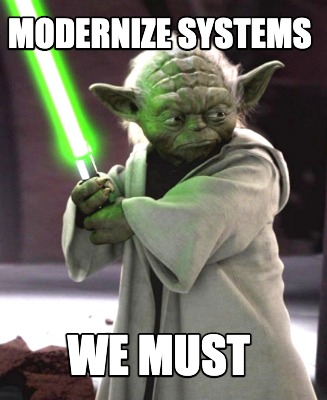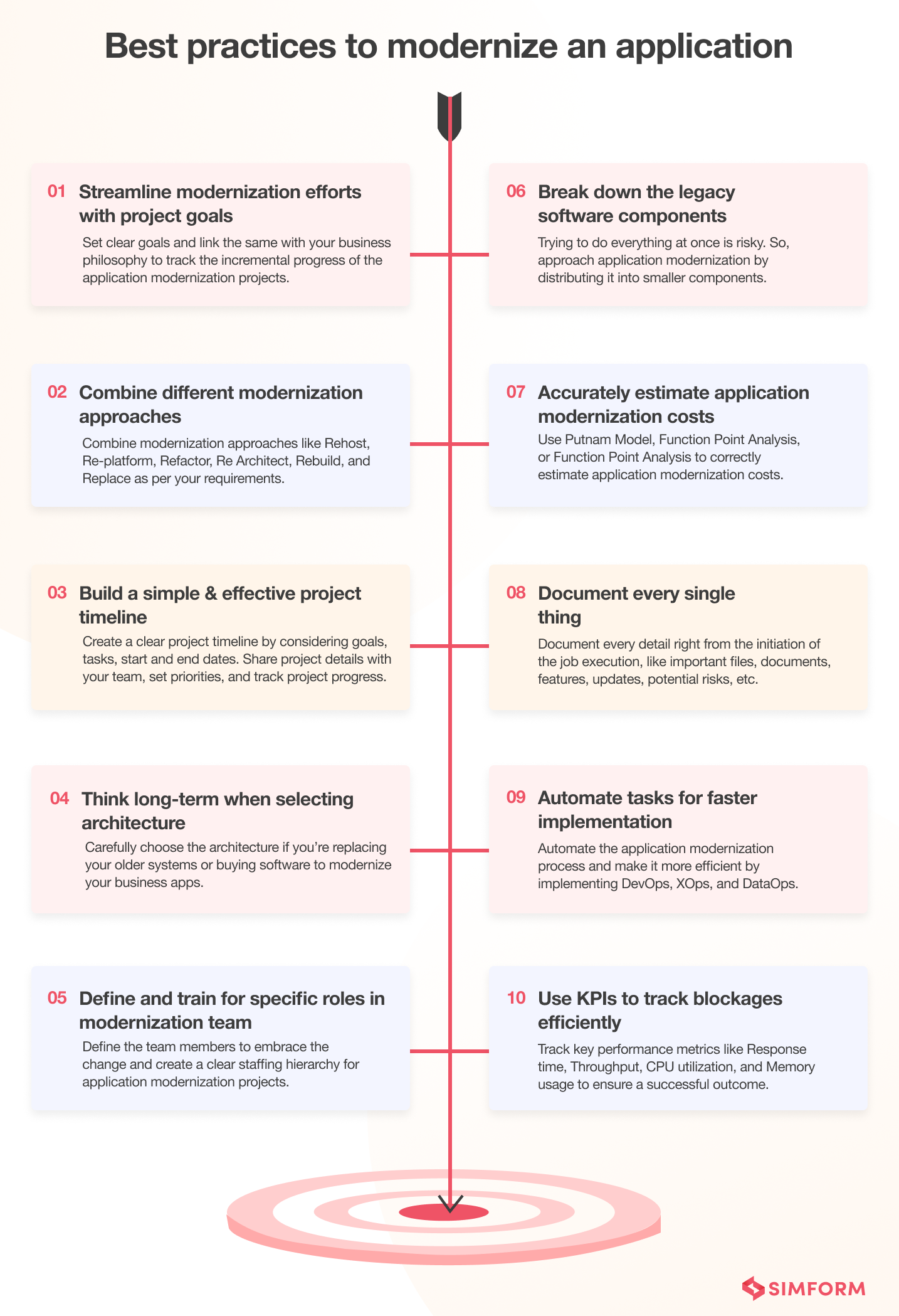The ever-changing market scenario urges enterprises to undergo a 180-degree shift in their existing processes and workflows. However, even today, most enterprises have core applications that operate on an on-premises dedicated environment causing roadblocks to success, such as – reduced productivity and scope of innovation, ineffective data management, security vulnerability, etc.
Application modernization is the solution to many challenges and undeniably plays a significant role in accelerating the digital transformation journey for any enterprise. But, from the hasty discovery phase to lack of clarity, many factors hold modernization initiatives from succeeding.
This article uncovers the best practices you must embrace to avoid common roadblocks in your application modernization journey.
Application modernization best practices to follow
Modernization frees businesses from the constraints of outdated applications. But it is one of the most demanding business endeavors that sometimes result in money loss and time and team-related challenges.
Here are some prime reasons for the failure of app modernization projects:
- Inadequate skills or professional training
- A disconnect between business and technical teams
- Changes within the organizational structure
- Failure to set accurate project expectations
- Lack of smart tools and technologies

Every team faces legacy modernization challenges. But committing to the process is the first step to taking them head-on. Here are the practices you can use to move forward on the legacy modernization path seamlessly:

1. Align modernization efforts with measurable objectives
Linking your modernization efforts to measurable business and IT goals allows you to gauge the success of the initiative. For example, faster time to market and better agility embedded with new features can show progress.
To kick off the goal-setting process, you must identify the highest priority and most critical applications. Then, analyze how the company would benefit from increased reliability, scalability, and performance by leveraging its cloud service provider.
2. Use combination of modernization approaches in phases
There are six popular approaches for modernization, viz. Rehost, Re-platform, Refactor, Re Architect, Rebuild, and Replace. You can start with any of these approaches and then may use others, if required, to make the most out of the modernization of applications.
For instance, you can first rehost your application in the cloud without making any changes to the software code. Then you can replatform it to swap the existing database with an efficient cloud-based solution.
You can refactor a high-priority application first to take advantage of additional cloud technologies. So, choose the best approach that suits your application type.
3. Build a simple & effective project timeline
Prepare a clear modernization timeline by considering project goals, tasks, assignments, and start and end dates. For this, you should communicate with the project team about project tasks, set priorities, and track project progress across objectives.
You can use specialized software or a convenient tool like GanttPRO, Hive, Forecast, ClickUp, etc., to plan app modernization timelines. This type of software allows you to:
- View project timelines
- Define success metrics
- Display project milestones and dependencies
- Task breakdown, along with assignee details and due dates
4. Think long-term when selecting the architecture
Architecture is critical to any modernization project as it determines how well your application integrates with other systems. Furthermore, it specifies an application’s scalability and ensures security.
If you are considering replacing your older systems or buying software to modernize your business apps, then you should look at the architecture. Think about the below questions carefully before choosing new application architecture:
- What is it built on?
- Will it lock you down?
- Does it restrict you in any way?
Select an architecture that makes it easy to work with DataOps, DevOps, Cloud, and other automated processes.
5. Define and train for specific roles in the modernization team
It’s not enough to deploy new applications; driving and sustaining change requires a company-wide transformed skillset and operating model. In addition, you should define the type of team members to embrace the change.
Here is the staffing hierarchy of application modernization projects:
- C-suite executives — chief information security officer (CISO), CTOs, chief information officer (CIO), and chief security officer (CSO) are a part of it. They are the ones to choose the staff for the modernization effort.
- Product Owner – Sets project requirements from the customer’s viewpoint. This role, typically filled in-house, assigns team roles and tasks and takes full responsibility for customer success.
- Project Manager – Responsible for leading teams, tracking progress, defining goals, and ensuring project goals align with the estimated budget.
- Modernization Architect – A professional responsible for translating business requirements into technical deliverables to effectively integrate the modernized app into the cloud environment.
- Legacy App Expert – Can analyze the app to understand its functionality and dependencies that you should consider while restructuring the same into microservices
- Senior Developers – Individuals with the normal range of application development skills like front-end or back-end developers or UI/UX designers.
- QA Engineer – Defines comprehensive test coverage to ensure that each microservice and the restructured app function as intended.
The enterprise architecture team balances the requirements of the business community for goods and services with IT capabilities. The group is also in charge of formulating a plan to modernize old applications to carry out the overall business strategy.
6. Break down the components of legacy software
Approaching modernization from a Big Bang standpoint is quite overwhelming. Trying to do everything at once is not only exhausting but also risky. Moreover, if there are any issues, it may quickly bring the business to a standstill.
On the other hand, it is far simpler to modernize applications by distributing it into smaller pieces or goals. Here is how you can do that:
- Defragment every single aspect of that application: network configurations, servers, storage configurations, and app deployment
- Model networking among the individual components
- Deconstruct that model into its different configurations
By separating your legacy software into smaller chunks, you can tackle them independently.
7. Use software estimation models
Many enterprises believe their software will work for decades without other investments. But this is not true, as legacy applications eventually have compatibility issues and become insecure to use. And so if they accept the reality and start modernizing the applications at the right time, they can ultimately save more.
Initially, modernization may look costly. But in fact, system replacement saves more money and improves operational excellence. Here are a few approaches to estimating the cost of modernizing legacy apps:
- Putnam Model – Putnam Model allows a company to forecast time, afford what they need to finish the project, and get the correct estimation of modernization cost.
- Constructive Cost Model – Created in 1981 by Barry Boehm, the Constructive Cost Model (Cocomo) is a regression model based on the number of Lines of Code used to estimate the project’s cost.
- Function Point Analysis – Allan J Alberchet gave this approach in 1979. Function Point Analysis is a standardized method to size the software work product functionally of what the user requests and receives in return.
8. Document every tiny detail
Documentation serves as a tool for maintenance and a foundation for future transformations.
Here is how you can get started with documentation:
- Document every detail from the initiation of the job execution to the various touchpoints, like the files and programs you will use during the development process.
- Describe relevant features and updates.
- Determine the amount you are willing to allocate for the modernization of the application.
- Record any changes you introduce to the process.
Overall, detailed documentation is a critical step toward the digital transformation of aging applications.
9. Expedite tasks with automation
Your modernization plan should involve speeding up your software delivery cycle and offering value to the company in less time. However, this ultimately relies on automation. And here are some of the ways you can automate the app implementation:
- Harness the power of DevOps to get automation and collaboration tools for faster data changes and quicker application delivery.
- Use DataOps to accelerate your data delivery to analysts and data scientists for insights.
- You can integrate XOps to remove the organizational silos and ensure better collaboration among data scientists, IT teams, and software engineers.
10. Identify bottlenecks with performance metrics
Your work isn’t completed after streamlining the application modernization journey. You should also measure the performance of the modernization process to ensure a successful outcome. Here are some performance metrics that you need to track:
- Response time — the amount of time to process a request and a response to be returned
- Throughput — the number of requests you can process per unit of time
- CPU utilization — the percentage of the CPU used by the application
- Memory usage — the amount of memory used by the application
Tracking these performance metrics will help to identify bottlenecks and potential issues. Also, it enables you to track the application’s performance in real-time and improve the same if needed.
Achieve faster application modernization with Simform
App modernization approach lends you a helping hand by offering some remarkable benefits:
- Accelerated digital transformation
- Support for cloud adoption
- Fetching attractive business opportunities
- Improved operational efficiency and standardization
- A culture of automation and change of operations
Integrating the best practices can help you modernize your legacy applications in a true sense. Simform can assist you in preparing a customized roadmap to adopt modern cloud technologies to generate better revenues. Feel free to connect with our consultants to kickstart your journey to application modernization.